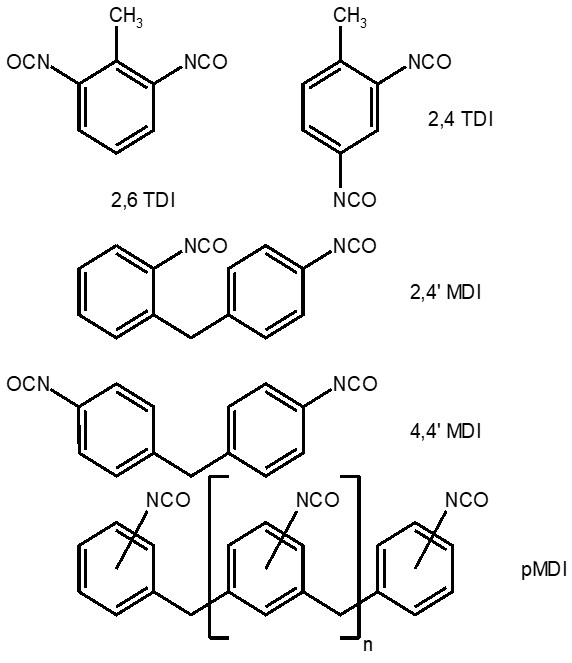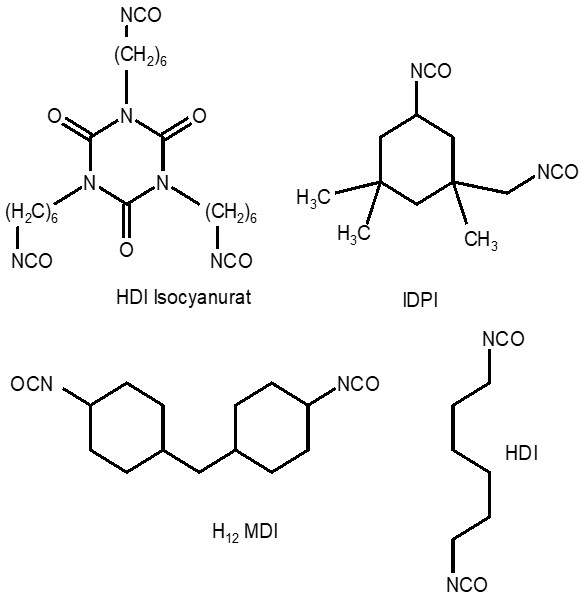
Fig. 1: Aromatic isocyanates
Isocyanates
Classic isocyanate-processing industries are the plastics industry, the automotive industry, the construction and building materials industry, the textile and shoe industry, the furniture industry (upholstery foams) and the coatings industry.
Isocyanates play an important role as hardener components in the production of 1C and 2C component polyurethanes. Depending on the application substances with two, three or more functional isocyanate groups are used. These plastics are characterized by toughness, flexibility and strength and are used in sealants, casting resins, foams and other products.
There are two main types of isocyanates:
- Aromatic isocyanates: These react faster with the polyol component and result in materials with better mechanical properties. However, they tend to yellow.
- Aliphatic und cycloaliphatic isocyanates: These are often used for applications with high requirements for light and weather resistance and transparency, e.g. coating materials for outdoor use.
Prepolymers are also used as hardeners. These are created by the reaction of isocyanates with polyols in the bottom shot resulting in isocyanates with increased molecular weight, higher viscosity, lower isocyanate content and lower vapour pressure.
Industrially produced isocyanates are subject to EU Regulation 2020/1149, which requires that suitable training must be provided for employees who handle such substances if they contain more than 0.1% diisocyanates. An exception to this is purified, oligomeric hexamethylene diisocyanates (HDI isocyanurates with a diisocyanate content of less than 0.1%), for which there is no special training required.
A selection of versatile basic isocyanates and special types is available in our product portfolio.
We will be happy to provide you with further information on request.
Further information can be found on the following website safe use Diisocyanates.

Fig. 2: Aliphatic isocyanates
Isocyanates in industry: TDI and MDI
The industrial use of isocyanates is widespread, with toluene diisocyanate (TDI) being favoured for elastic systems and methyldiphenyl diisocyanate (MDI) for harder systems. These aromatic isocyanates offer advantages such as increased reactivity compared to aliphatic isocyanates and technically easier accessibility, which leads to lower costs in the production of casting resins. They are produced from crude oil using a multi-stage synthesis process that also utilises the highly toxic phosgene.
The most commonly used isocyanate in the world is MDI. MDI synthesis produces a mixture of various ‘pure’ MDI isomers and polynuclear MDI oligomers which are separated by distillation. Pure MDI types have an NCO functionality of 2. On the other hand technical MDI usually consists of polynuclear aromatic MDI types with a functionality of more than two MDI types. These are well suited for the construction of cross-linked polymer structures and are referred to as crude MDI or polymeric MDI (pMDI). In particular pMDI types such as ISO-CURE MDI 32-120 are widely used as hardeners for cold-curing 2-component polyurethane casting resins. The chemical industry offers a wide range of pMDI grades which, depending on their structure and composition, can influence the physical and chemical properties of the resulting casting resins.
Aliphatic isocyanates: HDI, IPDI and H12MDI
The most important types of aliphatic isocyanates are isophorone diisocyanate (IPDI), hexamethylene diisocyanate (HDI) and hydrogenated MDI (H12MDI).
The trimers of HDI, isocyanurate and biuret, are also categorised as aliphatic isocyanates. Although strictly speaking they are modified isocyanates, they consist of three monomeric HDI units. These isocyanates can be produced particularly pure with a diisocyanate content of less than 0.1 %, which facilitates their use without the aforementioned training requirement. An example of such a system is our ISO-CURE HDI 23-2000.
Aliphatic isocyanates have no conjugated double bonds and therefore do not interact with light and are the preferred choice for particularly light and weather resistant polyurethanes. Therefore transparent casting resins and resins for outdoor applications and coatings are preferably produced with them.
From an industrial point of view, many aliphatic diisocyanates are problematic as they are highly toxic. However, this does not apply to the trifunctionally modified HDI isocyanates (isocyanurates and biurets), which are only classified as ‘irritant’. HDI isocyanurates are frequently used in the manufacture of elastomers while IPDI PU polymers produce moulded resins with very good mechanical properties.
Compared to the pMDI types the aliphatic isocyanates are in some cases significantly more expensive and are therefore not used as frequently as hardeners in casting resins. Their reactivity is significantly lower than that of aromatic isocyanates, which enables long processing times if required. However, if fast-curing resins are required considerable quantities of catalysts often have to be added, which can be a cost factor.
Modified isocyanates: Prepolymers and semi-prepolymers
Prepolymers are of great importance in the chemical industry and are produced from various standard isocyanates and their mixtures. Although they are generally more expensive than base isocyanates due to their complex production process, they are available in a wide range of types.
Prepolymers are produced by reacting an excess of isocyanate with polyols. This yields polymeric isocyanates with a reduced isocyanate content and different residual contents of monomeric isocyanates. For isocyanates with diisocyanate contents of less than 0.1 %, which do not fall under the statutory training obligations, purification is often necessary, e.g. by so-called ‘stripping’.
Mixtures of reacted isocyanates and remaining monomeric isocyanates are known as semi-prepolymers. A certain proportion of the unreacted isocyanate remains in the mixture. By specifically adjusting the cross-linking reaction, precise control over the molecular structure and the physical and chemical properties of the subsequent plastics and moulding resins can be achieved.
Due to the lower NCO content, prepolymers are less reactive as hardeners for casting resins. This leads to longer processing and curing times as well as less heat development during the curing process, which can be advantageous depending on the application (see explanation in the Prepolymers chapter).
Prepolymers: Fine tuning for improved properties
The use of prepolymers as hardener components can improve the mechanical properties and the robustness of the mixture ratios. These include tear resistance, elongation at break, tear propagation resistance and low-temperature flexibility.
The viscosity of the prepolymers depends on the extent of the crosslinking reaction that has already taken place. Prepolymers with very low NCO contents (advanced reaction) generally have a high viscosity. In some cases solvents are then required to adjust the viscosity.
When mixing polyol/resin and hardener components, incompatibilities can occur in which the components initially mix poorly or not at all. Specially adapted prepolymers can avoid these incompatibilities by adapting their structure accordingly to make the resin and hardener components compatible with each other. Another advantage of prepolymers is their lower toxicity due to the lower vapour pressure.
In addition to the substance groups discussed there are also other secondary groups such as blocked isocyanates, which can be activated by heat and processed as a single component.
Thanks to our many years of experience as users and developers we can also provide you with flexible support for individual wishes and product requirements.
Talk to us about your application requirements: Contact.



